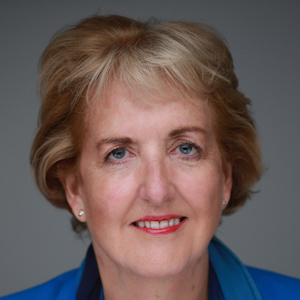
To mark International Women’s Day, our first feature today focuses on the relationship between a mentor and mentee from Women in BIM. Mentoring has been a successful initiative for Women in BIM. How does the mentor/mentee relationship work? What do both parties get out of it? BIMplus found out by speaking to Elaine Lewis, MD of Cadventure and non-executive director of nima, and Kinga Ciesielska, a BIM information manager at Aecom.
With a background in business and an MBA from Cranfield, Lewis joined her husband’s digital construction software business Cadventure and became MD in 2013. She says: “I got involved in mentoring via a Construction Industry Council event six years ago, which I really enjoyed. When Women in BIM chair and founder Rebecca De Cicco asked me to become a mentor, I jumped at the chance. Kinga is my third mentee and I really enjoy the work we do together. I met her in June last year.”
Ciesielska started work experience in the shipbuilding industry in Poland – “an all-male environment”, she remarks. Keen to learn English and to expand her horizons, she moved to the UK 10 years ago and started working in production at a publishing house.
“My career in BIM started with Airsculpt, using SketchUp and Autodesk to draw shade sail blinds for clients’ conservatories,” she reveals. “Keen to progress to a new challenge, I moved into the rail sector, joining Aecom, with responsibility for 3D design of overhead line equipment.”

“I was very invested in her success. Kinga asked me questions, listened and implemented the answers.”
Kinga’s journey
Ciesielska then moved as CAD technician into roads and bridges, learning ISO and BS1192 standards, and programmes like Synchro/Infraworks to develop 4D sequences and 3D modelling for bid teams at Hochtief Construction. She then moved to Costain as BIM coordinator, working on the regeneration of the Royal Navy’s Devonport facility in Portsmouth, where she used Synchro for 4D sequences, 3D modelling, and Solibri for clash detection.
“And now I’m back in the rail sector with Aecom,” she says. “I’m involved in the development of common data environments using ProjectWise as well as doing 3D modelling in Bentley. I am working on federated models with the discipline leads and provide project information management.”
She found out about Women in BIM through her previous line manager. She explains: “I applied to be mentored and they matched me up with Elaine. She’s supported me so much: it’s the best scenario that I could have hoped for.
“Elaine helped me improve my CV, gave me advice on developing myself and gaining accreditations and growing my network.”
Lewis says: “I’m really proud of what Kinga has achieved. She’s done incredibly well, moving from being a CAD technician to a BIM information manager.”
BIMplus: How does Women in BIM’s mentoring process start?
Elaine Lewis: It’s quite a rigorous process. Women in BIM gets more mentee applications than they have mentors. The mentee has to fill in a detailed questionnaire about what they’re looking for, what their aspirations are, what they want to get out of the programme.
From the mentor’s side, Women in BIM wants to understand whether somebody has got the skills, the time the empathy, the interpersonal skills, and what their motivation is to become a mentor.
When it comes to the matching process, Women in BIM is looking to find people that have complementary skills, people with complementary experiences, or it might be a question of opposites attract.
When I meet other mentors, we always say we are thrilled with the matching process. I would suggest that these relationships never really fall over because Women in BIM puts so much time and effort into making sure people get the right person.
Kinga Ciesielska: I’d never been mentored before. Everything I’d learned, I’d learned myself until that stage. I needed someone to push me, to help me look for information and to improve my knowledge. I feel stronger thanks to my time with Elaine.
How does the mentor/mentee relationship work?
EL: We set up a ‘get to know you’ session, so I could understand what Kinga was looking for and how I could help her. We set up the basis of the mentoring and agreed a schedule. We met once a month for an hour on a Thursday afternoon, but Kinga knew she could contact me at any time in between the scheduled meetings.
Not that there was any issue with Kinga, but it’s quite important for a mentor to set boundaries with the mentee.
KC: With Elaine, it’s not just about our scheduled meetings. When I had an interview, she messaged me to find out how it went. Outside of home and work, Elaine is someone who I can always count on for support in the work or private environment.
EL: Although our six-month mentoring process concluded in December last year, I feel like Kinga and I will be in touch forever.

“I’d never been mentored before. I needed someone to push me, to help me look for information and to improve my knowledge.”
What’s been the highlight?
EL: Supporting Kinga to get the new job. I was very invested in her success. Kinga asked me questions, listened and implemented the answers. Because of my role at Cadventure, I was able to give her the interviewer’s perspective.
KC: I was thinking I wasn’t good enough to progress, to go for another job, but Elaine convinced me. She helped me reformat my CV, highlight my strong points and knowledge, and helped me to prepare for the interview. Elaine helped empower me. I started to believe that I could do it.
What would you say to those of becoming a mentor or those wanting to be mentored?
EL: Do it! I was at the Women in BIM 10th anniversary event and there were so many people there interested in becoming mentors. You don’t have to be a woman: Cohesive’s Dave Philp is a mentor. When thinking about being a mentor, there can be a bit of imposter syndrome: “Why would anyone want me as their mentor? What could they learn?” My answer is: “Give it a go. Why not?”
KC: I would definitely recommend it. I realised I’m not alone, I know more people in a similar situation who can support me and advise me. If you want to learn something more or want to feel more powerful and achieve more, being mentored is a great idea. I didn’t believe I could grow my career and look, I did.
EL: It’s not a one-way street. Being a mentor is satisfying. It’s uplifting, rewarding. It’s a two-way street and you can learn from one another.
Don’t miss out on BIM and digital construction news: sign up to receive the BIMplus newsletter.












